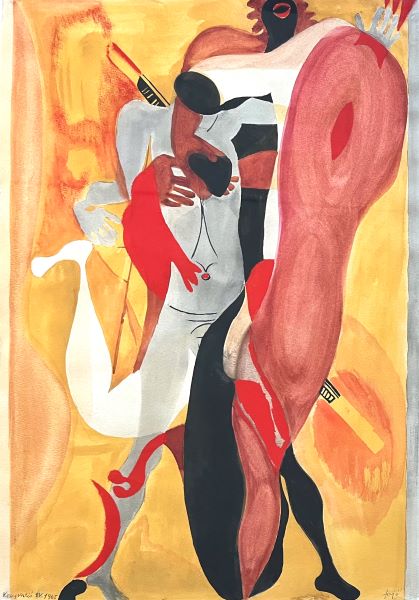Biography
He studied decorative painting at the Hungarian Academy of Arts between 1956-1961, his teachers were: Pál Miháltz, György Z. Gács, Lajos Szentiványi, and he considers Lajos Kassák as his master. Study trips: 1960: Soviet Union, 1965: Egypt, 1969: Vienna, Basel, Paris, London, Nuremberg, [with Lajos Kassák's widow]; From 1974, one of the founding members of the Budapesti Műhely; 1976: one of the founders of the metal sculptor workshop and symposium in Győr. 1976-1988: artistic director of the Józsefváros Exhibition Hall and the Szerencs summer free school; Between 1985-1996, he had a working relationship with Max Bill and Victor Vasarely. 1985: Munkácsy Award; 2008: Kossuth Prize, was a teacher at the Hungarian Academy of Applied Arts.
His individual style, which emerged in the second half of the 60s, is mainly based on geometric traditions and the constructivist approach to art. His works are also influenced by the program of op-art, minimal art and new geometry. His spiritual master is Lajos Kassák, whose works Fajó organized an exhibition at the Club of Young Artists in 1965. The compositional principle of his pictures is reduction, which is based on the reduction of natural forms to basic geometric forms and the variability of these reductive elements. In his works, the exact system of forms combined with the basic colors and their variations results in a harmonious world of colors and forms, and a system of clear proportions. Contrary to the impersonal, modeling approach of minimal art, however, his art preserves its empirical roots, and sensuality plays a decisive role in his works through the curved world of shapes derived from the circle. Duplication is an important part of his creative method. In addition to oil-on-canvas images, serigraphy is a means of creating sterile, homogeneous surfaces, the final tone of color, and the democratization of artwork.
In 1971, with Imre Bak, they formulated the program of a group of artists representing the progressive art of the era, who presented themselves at the Studio 66 exhibition and were connected to the spirit of the artists of the former Zugló circle. The essence of this manifesto lies in the expansionist intentions of their artistic experiments and the social integrability of their aspirations. In 1974, in addition to the mentioned artists, Fajó together with Ilona Keserü, András Mengyán and Tamás Hencze set up the graphic screen printing "Workshop", which later became known as Budapesti Műhely.
His plastic world is closely related to his painting. His sculptures are actually spatial realizations of principles developed on a two-dimensional surface. He creates his own sculptural form from the basic geometric shapes that appear on the canvases and screen prints: the circle, the square, the triangle. In the 1960s, he mainly made folded paper cutouts, later on he applied the raw materials and processing techniques of the sculptures ~ basically in connection with the idea of the work, in an organic way. The cover designs for Magvető Kiadó's Quick time series were created by him.

